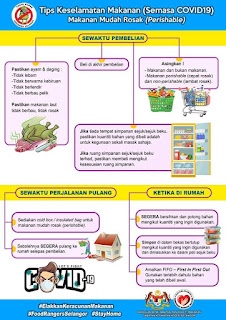Eggs are rich in protein. Many of us consumed it, almost everyday, for breakfast. Remember during the MCO period, while we cannot go out often, what is the best food that keep us energetic? Yes, I believe egg is one of the cheapest and the best food for giving us nutrition.
But, do you know that eggs should be cleaned before you crack it to cook or boil it ?
Egg skin might contain dust, mud or chicken feaces. Some of us might not check the cleanliness of the egg before purchasing it. The egg tray might also dirty as it is paper made and couldn't be washed . So, if we are not washing the eggs, the dirts and more dangerous is, the feaces might drop to the pan / pot or contaminate our hands while we are holding the egg. This causes food contamination.
Chicken feaces contains Salmonella. This bacteria causes Typhoid that patient will suffered of stomach pain, diarrhea, vomit and could causing death. So, imagine that if we do not cook the egg thoroughly or the egg skin pieces drop into the egg, the contaminant will stay in it and consumer will have food poisoning after consuming it.
So, first of all we should make sure the eggs does not crack. Cracked eggs should be threw away as the inner part of the egg had been contaminated. Secondly, we should wash the egg before cracking it for cooking or boiling it. Use water that is slightly warmer than the egg's temperature. Avoid cold water entirely. Cold water can cause the pores in an eggshell to suck bacteria from the surface and into the egg where you don't want it. Never immerse or soak the eggs in water for more than 3 minutes. Wash the eggs under running water.
After washing, let them sit and wipe dry with a dry paper towel one at a time. Place the clean eggs in another clean container or tray. Do not putting back the egg to the holder. Store eggs pointed-side down to keep them fresh longer. Refrigerate the eggs immediately if you are not cooking them right away.
There have been argument in developing countries about to wash or not to wash the eggs. But, it is better for us to wash it, considering the hazards of the feaces contents on the egg shell.
















